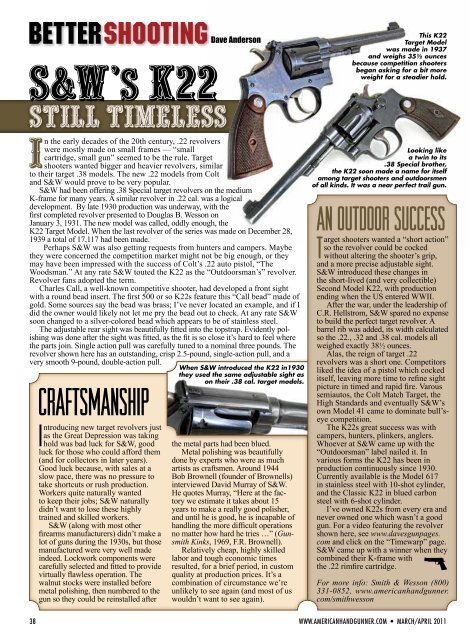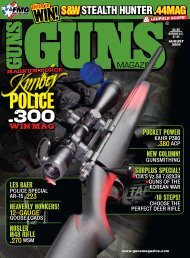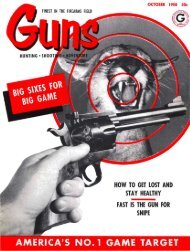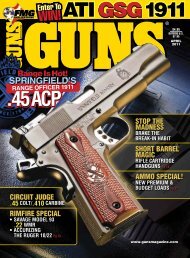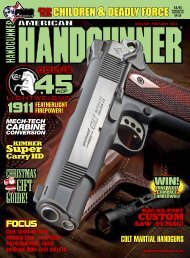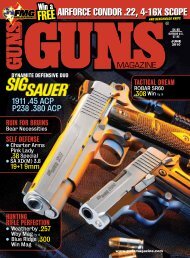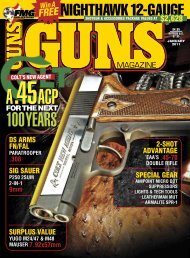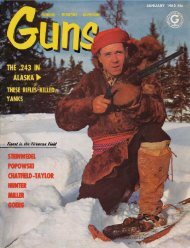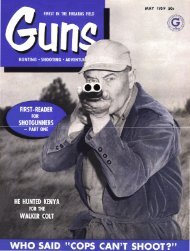MAGNUM MAGNUM - Jeffersonian
MAGNUM MAGNUM - Jeffersonian
MAGNUM MAGNUM - Jeffersonian
Create successful ePaper yourself
Turn your PDF publications into a flip-book with our unique Google optimized e-Paper software.
BETTERSHOOTING Dave Anderson<br />
S&W’s K22<br />
Still Timeless<br />
In the early decades of the 20th century, .22 revolvers<br />
were mostly made on small frames — “small<br />
cartridge, small gun” seemed to be the rule. Target<br />
shooters wanted bigger and heavier revolvers, similar<br />
to their target .38 models. The new .22 models from Colt<br />
and S&W would prove to be very popular.<br />
S&W had been offering .38 Special target revolvers on the medium<br />
K-frame for many years. A similar revolver in .22 cal. was a logical<br />
development. By late 1930 production was underway, with the<br />
first completed revolver presented to Douglas B. Wesson on<br />
January 3, 1931. The new model was called, oddly enough, the<br />
K22 Target Model. When the last revolver of the series was made on December 28,<br />
1939 a total of 17,117 had been made.<br />
Perhaps S&W was also getting requests from hunters and campers. Maybe<br />
they were concerned the competition market might not be big enough, or they<br />
may have been impressed with the success of Colt’s .22 auto pistol, “The<br />
Woodsman.” At any rate S&W touted the K22 as the “Outdoorsman’s” revolver.<br />
Revolver fans adopted the term.<br />
Charles Call, a well-known competitive shooter, had developed a front sight<br />
with a round bead insert. The first 500 or so K22s feature this “Call bead” made of<br />
gold. Some sources say the bead was brass; I’ve never located an example, and if I<br />
did the owner would likely not let me pry the bead out to check. At any rate S&W<br />
soon changed to a silver-colored bead which appears to be of stainless steel.<br />
The adjustable rear sight was beautifully fitted into the topstrap. Evidently polishing<br />
was done after the sight was fitted, as the fit is so close it’s hard to feel where<br />
the parts join. Single action pull was carefully tuned to a nominal three pounds. The<br />
revolver shown here has an outstanding, crisp 2.5-pound, single-action pull, and a<br />
very smooth 9-pound, double-action pull.<br />
Craftsmanship<br />
Introducing new target revolvers just<br />
as the Great Depression was taking<br />
hold was bad luck for S&W, good<br />
luck for those who could afford them<br />
(and for collectors in later years).<br />
Good luck because, with sales at a<br />
slow pace, there was no pressure to<br />
take shortcuts or rush production.<br />
Workers quite naturally wanted<br />
to keep their jobs; S&W naturally<br />
didn’t want to lose these highly<br />
trained and skilled workers.<br />
S&W (along with most other<br />
firearms manufacturers) didn’t make a<br />
lot of guns during the 1930s, but those<br />
manufactured were very well made<br />
indeed. Lockwork components were<br />
carefully selected and fitted to provide<br />
virtually flawless operation. The<br />
walnut stocks were installed before<br />
metal polishing, then numbered to the<br />
gun so they could be reinstalled after<br />
When S&W introduced the K22 in1930<br />
they used the same adjustable sight as<br />
on their .38 cal. target models.<br />
the metal parts had been blued.<br />
Metal polishing was beautifully<br />
done by experts who were as much<br />
artists as craftsmen. Around 1944<br />
Bob Brownell (founder of Brownells)<br />
interviewed David Murray of S&W.<br />
He quotes Murray, “Here at the factory<br />
we estimate it takes about 15<br />
years to make a really good polisher,<br />
and until he is good, he is incapable of<br />
handling the more difficult operations<br />
no matter how hard he tries …” (Gunsmith<br />
Kinks, 1969, F.R. Brownell).<br />
Relatively cheap, highly skilled<br />
labor and tough economic times<br />
resulted, for a brief period, in custom<br />
quality at production prices. It’s a<br />
combination of circumstance we’re<br />
unlikely to see again (and most of us<br />
wouldn’t want to see again).<br />
This K22<br />
Target Model<br />
was made in 1937<br />
and weighs 35½ ounces<br />
because competition shooters<br />
began asking for a bit more<br />
weight for a steadier hold.<br />
Looking like<br />
a twin to its<br />
.38 Special brother,<br />
the K22 soon made a name for itself<br />
among target shooters and outdoorsmen<br />
of all kinds. It was a near perfect trail gun.<br />
An Outdoor Success<br />
Target shooters wanted a “short action”<br />
so the revolver could be cocked<br />
without altering the shooter’s grip,<br />
and a more precise adjustable sight.<br />
S&W introduced these changes in<br />
the short-lived (and very collectible)<br />
Second Model K22, with production<br />
ending when the US entered WWII.<br />
After the war, under the leadership of<br />
C.R. Hellstrom, S&W spared no expense<br />
to build the perfect target revolver. A<br />
barrel rib was added, its width calculated<br />
so the .22., .32 and .38 cal. models all<br />
weighed exactly 38½ ounces.<br />
Alas, the reign of target .22<br />
revolvers was a short one. Competitors<br />
liked the idea of a pistol which cocked<br />
itself, leaving more time to refine sight<br />
picture in timed and rapid fire. Varous<br />
semiautos, the Colt Match Target, the<br />
High Standards and eventually S&W’s<br />
own Model 41 came to dominate bull’seye<br />
competition.<br />
The K22s great success was with<br />
campers, hunters, plinkers, anglers.<br />
Whoever at S&W came up with the<br />
“Outdoorsman” label nailed it. In<br />
various forms the K22 has been in<br />
production continuously since 1930.<br />
Currently available is the Model 617<br />
in stainless steel with 10-shot cylinder,<br />
and the Classic K22 in blued carbon<br />
steel with 6-shot cylinder.<br />
I’ve owned K22s from every era and<br />
never owned one which wasn’t a good<br />
gun. For a video featuring the revolver<br />
shown here, see www.davesgunpages.<br />
com and click on the “Timewarp” page.<br />
S&W came up with a winner when they<br />
combined their K-frame with<br />
the .22 rimfire cartridge.<br />
*<br />
For more info: Smith & Wesson (800)<br />
331-0852, www.americanhandgunner.<br />
com/smithwesson<br />
38 WWW.AMERICANHANDGUNNER.COM • MARCH/APRIL 2011


